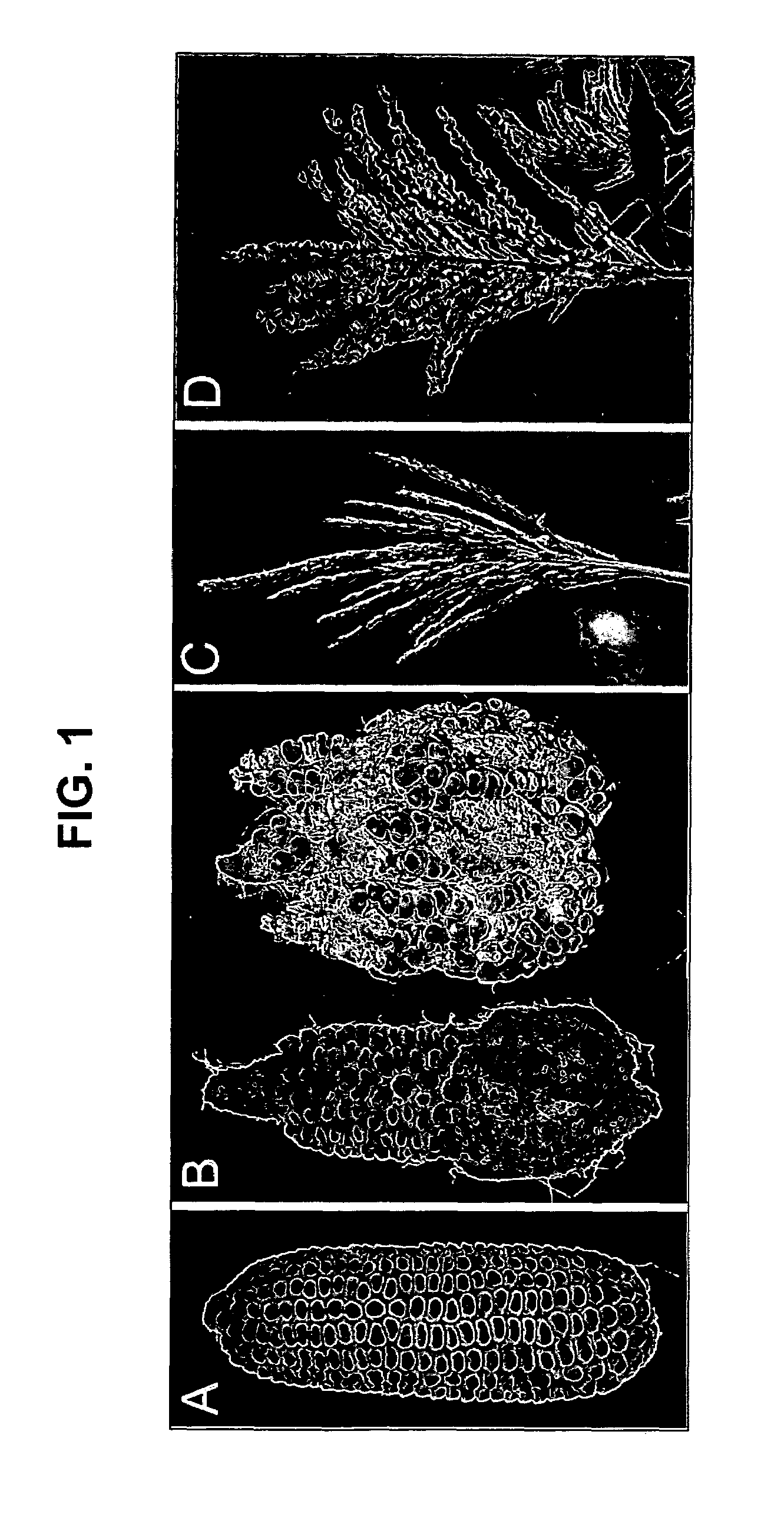Nucleotide sequences encoding RAMOSA3 and sister of RAMOSA3 and methods of use for same
a technology of ramosa3 and ramosa2, which is applied in the field of protein and nucleotide sequences and genetics, can solve the problems of loss-of-function tps1 mutants, embryo lethal, and reducing hexokinase activity did not rescue the growth of arabidopsis tps1 embryos, etc., and achieves the effects of reducing the branching of the tassel, reducing
- Summary
- Abstract
- Description
- Claims
- Application Information
AI Technical Summary
Benefits of technology
Problems solved by technology
Method used
Image
Examples
example 1
Phenotypic Analysis of ra3 Mutants
[0257]A mutant line with branched inflorescences was isolated in a non-targeted Mutator (Mu) transposon tagging family, and found to be an allele of ramosa3 (ra3). Although ra3 is a classical mutant of maize, first described in 1954 by H. S. Perry (see also, Table 1 of Veit et al. Plant Cell 5:1205-1215 (1993)), it had not been characterized in detail. Only the mature inflorescence phenotype had been reported, and there was some confusion about the map location, as explained below in Example 2.
[0258]To analyze ra3 mutant phenotypes, ra3 reference allele plants (ra3-ref, Maize Genetics CoOp Stock Center) were introgressed into B73 for at least 3 generations. During vegetative development, no differences were observed in ra3 plants compared to wild type sibs. In the inflorescence stage, ra3 mutants had irregular long branches in the ears, whereas wild type sib ears had a more compact and organized rachis. Also, irregular seed rows were present in cont...
example 2
Mapping and Isolation of ra3
[0264]According to the maize genetic map available, in 2004, at the Maize Genetics and Genomics Database, ra3 was listed as being mapped to chromosome 4; however, we were unable to reproduce those results. To address this discrepancy, ra3 and sib DNAs were provided for analysis by the the Missouri Maize Mapping Project [Coe, E., Cone, K., McMullen, M., Chen, S. S., Davis, G., Gardiner, J., Liscum, E., Polacco, M., Paterson, A., Sanchez-Villeda, H., Soderlund, C., and Wing, R., Access to the maize genome: an integrated physical and genetic map. Plant Physiol, 2002. 128(1): p. 9-12.].
[0265]Using bulk segregant analysis, ra3 was mapped to chromosome 7, bin 4.
[0266]For more detailed mapping studies, larger mapping populations were constructed using the ra3-ref allele and an allele (“ra3-fea1”) that was isolated from a Mu line carrying a fasciated ear mutant (fea1, [Jackson, D. and Hake, S., The genetics of ear fasciation in maize. Maize Genetics Cooperation N...
example 3
RA3 and SRA Gene Structure and Phylogenetic Analysis
[0271]The nucleotide sequence shown in SEQ ID NO:15 was deduced from BAC c038K01, and encodes the RA3 gene with 3 kb of sequence upstream (5′) of the ATG initiation codon, and 7.5 kb downstream (3′) of the TGA stop codon. Note that exons in SEQ ID NO:15 are displayed only for the region from the start codon to the stop codon, and are not shown for the 5′ or 3′ Untranslated Regions (5′- and 3′-UTRs).
[0272]The cDNA sequence corresponding to the RA3 region was isolated by reverse transcription of poly(A)-RNA followed by PCR. The Quiagen OneStep RT-PCR kit was used according to the manufacturers specifications. The primer set used was NS432 (SEQ ID NO:16) and NS411 (SEQ ID NO:17). SEQ ID NO:18 is the nucleotide sequence of the protein-coding region deduced from the PCR product obtained using the NS432 and NS411 primers. The corresponding amino acid sequence of the RAMOSA3 polypeptide is shown as SEQ ID NO:19.
[0273]The RA3 gene encodes ...
PUM
| Property | Measurement | Unit |
|---|---|---|
| size | aaaaa | aaaaa |
| diameter | aaaaa | aaaaa |
| volume | aaaaa | aaaaa |
Abstract
Description
Claims
Application Information
 Login to View More
Login to View More - R&D
- Intellectual Property
- Life Sciences
- Materials
- Tech Scout
- Unparalleled Data Quality
- Higher Quality Content
- 60% Fewer Hallucinations
Browse by: Latest US Patents, China's latest patents, Technical Efficacy Thesaurus, Application Domain, Technology Topic, Popular Technical Reports.
© 2025 PatSnap. All rights reserved.Legal|Privacy policy|Modern Slavery Act Transparency Statement|Sitemap|About US| Contact US: help@patsnap.com



